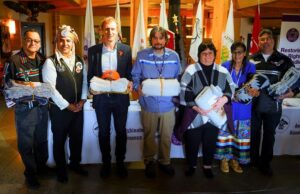An historic milestone for Anishinaabe Governance

By Rick Garrick
NIPISSING FIRST NATION – Leaders from the five signatory First Nations of the Anishinabek Nation Governance Agreement gathered together with Crown-Indigenous Relations Minister Marc Miller on Oct. 1 to commemorate the signing of the Agreement, as well as celebrate it coming into effect that day. The first self-government agreement of its kind in Ontario, the Governance Agreement was signed in April 2022 during a virtual ceremony, received Royal Assent on June 23, and came into effect on Oct. 1.
“It’s a beautiful day to be Indigenous — it’s a beautiful day to know that our self-governance agreement goes into effect,” says Moose Deer Point Gimaa Kwe Rhonda Williams-Lovett. “In February of 2020, right before COVID-19 hit, we signed our agreement. We were the first community.”
Gimaa Kwe Williams-Lovett says work has begun on behalf of the five signatory First Nations, Moose Deer Point, Zhiibaahaasing, Magnetawan, Nipissing, and Wahnapitae, noting that they are getting ready to hire a Chief Executive Officer.
“I’m pretty proud of the legacy that we are going to be leaving,” Gimaa Kwe Williams-Lovett says. “Our self-determination to govern in our own ways and to have our sovereignty respected by Canada is a positive step towards meaningful reconciliation.”
Zhiibaahaasing Chief Irene Kells says Anishinaabemowin is an important component of the Governance Agreement.
“It should always be number one, that language,” Chief Kells says. “That language is number one — that’s where it’s going to start and that’s where it’s going to be strong. We need to keep Anishinaabemowin alive in order for us to connect with our surroundings and be proud of who we are.”
Magnetawan Chief Lloyd Myke says the first day of the Governance Agreement being in effect was a day of change and a step forward for all of the five signatory First Nations.
“I’m excited for all our communities because the work we are going to be doing is a start, we’re leading the way,” Chief Myke says. “It’s a good time for our community, I’m looking forward to the work we are going to be doing and the laws that we’re going to create. Governance to Magnetawan Anishinabek is the next step forward in exercising our inherent right to govern ourselves, and position our community and membership in creating our Supreme Laws.”
The Honourable Marc Miller says it was important to make sure that every member of every party in Parliament was on board with the Governance Agreement, noting that they had unanimous consent.
“I am honoured to take part in today’s celebration with Anishinabek leadership, Elders, youth, and community members to mark this milestone in the implementation of the Anishinabek Nation Governance Agreement,” Miller says. “This is an important step away from the Indian Act for the signatory Anishinabek First Nations to implement their right to self-determination and their visions of a better future for their communities.”
Anishinabek Nation Grand Council Chief Reg Niganobe says Oct. 1 marks an important milestone in the implementation of the Anishinabek Nation Governance Agreement Act.
“We are honoured to be here with the B’Maakonigan communities and the Honourable Marc Miller to commemorate this unprecedented occasion,” Niganobe says. “We share in the collective enthusiasm at the vast potential this new Agreement will create for these signatory communities.”
Though absent from the in-person celebrations, Nipissing Chief Scott McLeod stated in a release that the Governance Agreement is positive step towards self-government.
“As our Nations strive to reassume our rightful jurisdictions over our own governance, the Anishinabek Nation Governance Agreement provides us with a tool to remove ourselves from sections of the Indian Act, freeing us to govern and protect our elections, language and culture, citizenship, and management and operations.”
Wahnapitae Chief Larry Roque says his community expresses their appreciation for this next step towards implementation of the Governance Agreement.
“We will be able to provide our citizens with the approaches and efficiencies within resource distribution that we were not able to before and service our community the way we have always intended,” Chief Roque says.
Pat Madahbee, Anishinabek Nation Commissioner on Governance and former Anishinabek Nation Grand Council Chief, says he first started hearing Anishinabek Nation leaders talking about getting out of the Indian Act about 48 years ago.
“Even our Getzit-baa Gordon Waindubence says act Indian, not Indian Act — he was trying to say as Anishinaabe, we have our own identity, we have our own worldview on how things should be done,” Commissioner Madahbee says. “We’ve logged a lot of miles over the years on not only the Education Agreement but this Governance Agreement. I remember going into Moose Deer Point — they were such a visionary community, they could see right from the get-go that this was a game-changer.”
Commissioner Madahbee says the five signatory First Nations are blazing the trail for the Anishinabek Nation First Nations.
“We haven’t come this far to only go this far, because very quickly, Child Well-being will be a part of this governance process, very quickly Health will be a part of this process,” Commissioner Madahbee says. “Then we’ll be looking at perhaps justice, economic issues, whatever comes down the pipe that the citizens direct.”
The Anishinabek Nation Governance Agreement was approved by the citizens of each signatory First Nation through a community vote over the past two years. The Anishinabek Nation began negotiations on governance with the federal government in 1995, which led to an Agreement-in-Principle in 2007.
The next step with the Governance Agreement involves the signatory First Nations passing their own laws to create and run their new governance system, with the work supported by increased funding to the First Nations to carry out their new responsibilities and invest in community priorities for a better future.


